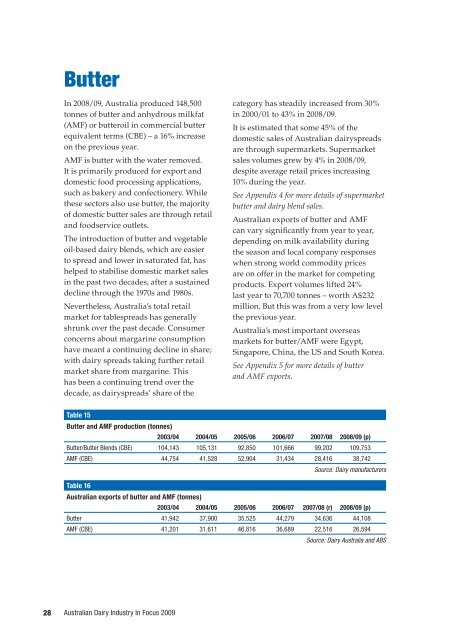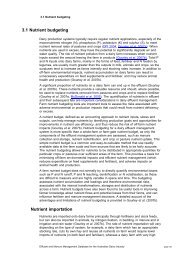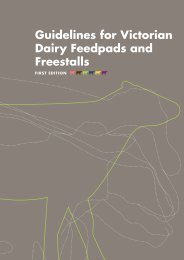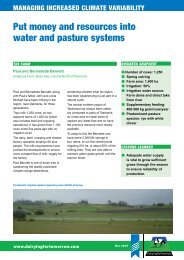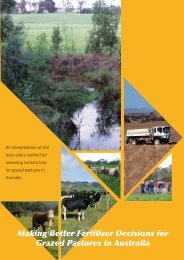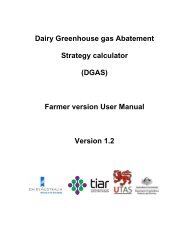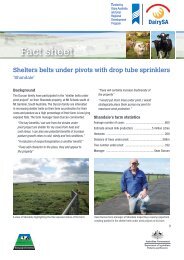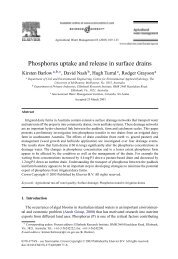Australian Dairy Industry In Focus 2009 - Dairying For Tomorrow
Australian Dairy Industry In Focus 2009 - Dairying For Tomorrow
Australian Dairy Industry In Focus 2009 - Dairying For Tomorrow
You also want an ePaper? Increase the reach of your titles
YUMPU automatically turns print PDFs into web optimized ePapers that Google loves.
Butter<br />
<strong>In</strong> 2008/09, Australia produced 148,500<br />
tonnes of butter and anhydrous milkfat<br />
(AMF) or butteroil in commercial butter<br />
equivalent terms (CBE) – a 16% increase<br />
on the previous year.<br />
AMF is butter with the water removed.<br />
It is primarily produced for export and<br />
domestic food processing applications,<br />
such as bakery and confectionery. While<br />
these sectors also use butter, the majority<br />
of domestic butter sales are through retail<br />
and foodservice outlets.<br />
The introduction of butter and vegetable<br />
oil-based dairy blends, which are easier<br />
to spread and lower in saturated fat, has<br />
helped to stabilise domestic market sales<br />
in the past two decades, after a sustained<br />
decline through the 1970s and 1980s.<br />
Nevertheless, Australia’s total retail<br />
market for tablespreads has generally<br />
shrunk over the past decade. Consumer<br />
concerns about margarine consumption<br />
have meant a continuing decline in share;<br />
with dairy spreads taking further retail<br />
market share from margarine. This<br />
has been a continuing trend over the<br />
decade, as dairyspreads’ share of the<br />
category has steadily increased from 30%<br />
in 2000/01 to 43% in 2008/09.<br />
It is estimated that some 45% of the<br />
domestic sales of <strong>Australian</strong> dairyspreads<br />
are through supermarkets. Supermarket<br />
sales volumes grew by 4% in 2008/09,<br />
despite average retail prices increasing<br />
10% during the year.<br />
See Appendix 4 for more details of supermarket<br />
butter and dairy blend sales.<br />
<strong>Australian</strong> exports of butter and AMF<br />
can vary significantly from year to year,<br />
depending on milk availability during<br />
the season and local company responses<br />
when strong world commodity prices<br />
are on offer in the market for competing<br />
products. Export volumes lifted 24%<br />
last year to 70,700 tonnes – worth A$232<br />
million. But this was from a very low level<br />
the previous year.<br />
Australia’s most important overseas<br />
markets for butter/AMF were Egypt,<br />
Singapore, China, the US and South Korea.<br />
See Appendix 5 for more details of butter<br />
and AMF exports.<br />
Table 15<br />
Butter and AMF production (tonnes)<br />
2003/04 2004/05 2005/06 2006/07 2007/08 2008/09 (p)<br />
Butter/Butter Blends (CBE) 104,143 105,131 92,850 101,666 99,202 109,753<br />
AMF (CBE) 44,754 41,528 52,904 31,434 28,416 38,742<br />
Source: <strong>Dairy</strong> manufacturers<br />
Table 16<br />
<strong>Australian</strong> exports of butter and AMF (tonnes)<br />
2003/04 2004/05 2005/06 2006/07 2007/08 (r) 2008/09 (p)<br />
Butter 41,942 37,900 35,525 44,279 34,636 44,108<br />
AMF (CBE) 41,201 31,611 46,816 36,689 22,516 26,594<br />
Source: <strong>Dairy</strong> Australia and ABS<br />
28<br />
<strong>Australian</strong> <strong>Dairy</strong> <strong><strong>In</strong>dustry</strong> <strong>In</strong> <strong>Focus</strong> <strong>2009</strong>


